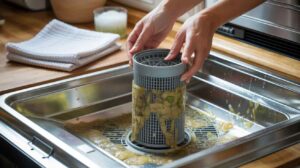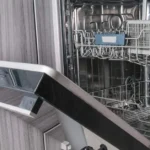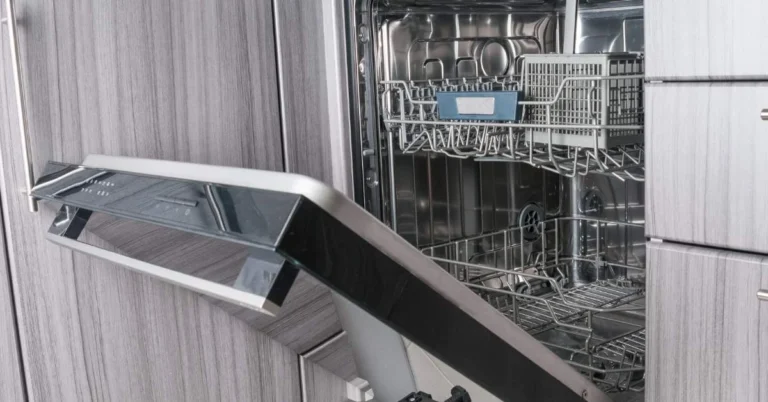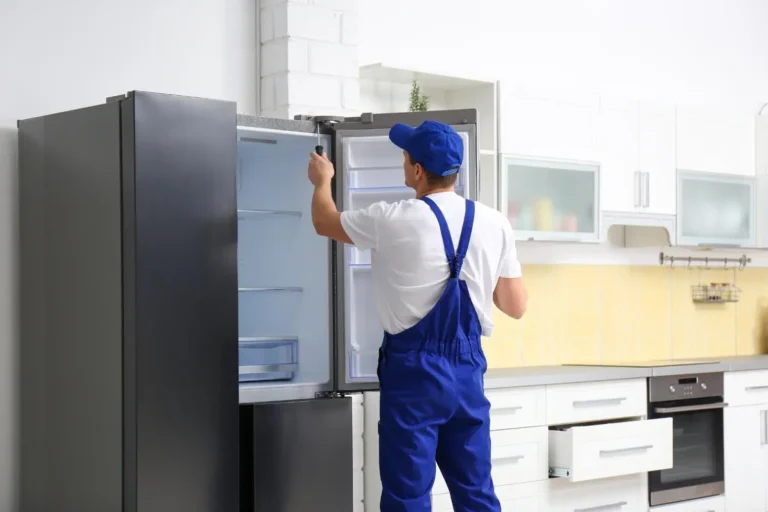I know how frustrating it can be to open your dishwasher after a cycle in your Niceville home, only to find a pool of dirty water sitting at the bottom. Not only is it annoying, but standing water can lead to unpleasant odors, mold growth, and potentially damage your kitchen floor if it eventually leaks out.
The good news is that Niceville residents can often fix a dishwasher not draining properly without calling a professional. In this guide, I’ll walk you through the most common causes of drainage problems and provide simple, step-by-step solutions you can try today and clarify when professional dishwasher repair service is necessary to keep your dishwasher safe & running smooth.
What Causes a Dishwasher Leaking Water?
Finding a puddle of water around your dishwasher can be alarming, but don’t panic! Most dishwasher leaks stem from common issues you can often fix without calling a professional. By identifying the source of the leak, you’ll save time and money while extending the life of your appliance. Let’s explore the most common causes of dishwasher leaks and how to address them.
1. Damaged Dishwasher Door
A worn or damaged door seal is one of the most frequent causes of leaks. Check your door gasket for cracks, tears, or food debris that might prevent a proper seal. If you notice damage, replacing the door seal is usually a simple fix that requires no special tools. You might also need to adjust the door latch if it’s not closing tightly enough to create a watertight seal.
2. Blocked Drain Filter
When your drain filter gets clogged with food particles and debris, water can’t flow properly and may back up and leak out. To fix this, locate the filter at the bottom of your dishwasher (usually a cylindrical piece), twist it counterclockwise to remove it, and rinse it thoroughly under running water. Make sure to clean it regularly, I recommend once a month to prevent future leaks.

3. Dishwasher Tub Leak
Over time, the dishwasher tub itself can develop cracks or holes, especially in older models. Examine the interior tub for visible damage, paying special attention to the corners and seams. Unfortunately, if you find cracks in the tub, it’s often more cost-effective to replace the dishwasher rather than repair just the tub, especially for units over 7-10 years old.
4. Loose Valves
Loose connections are common culprits for water leaks. Check the water supply line connected to your dishwasher and inspect all visible hoses and clamps. If you notice any dripping or moisture, tighten the connections with a wrench. Be careful not to overtighten, as this can damage the fittings and worsen the problem.
5. Detergent Issues
Using regular dish soap instead of dishwasher detergent can create excessive suds that push past the door seal. Always use detergent specifically designed for dishwashers and follow the manufacturer’s recommendations for quantity. If you’ve accidentally used the wrong soap, run an empty cycle with a tablespoon of vegetable oil to cut through the suds before your next regular wash.
6. Incorrect Alignment
If your dishwasher isn’t level, water can pool to one side and eventually leak out. Use a standard-level tool to check if your dishwasher is sitting evenly. If not, adjust the leveling feet at the bottom of the unit by turning them clockwise to raise or counterclockwise to lower each corner until the dishwasher is perfectly level.
7. Cracked or Damaged Spray Arm
A cracked spray arm can direct water toward the door seal rather than onto your dishes. Inspect the spray arms for any visible damage and ensure they spin freely. Also, check for food particles clogging the spray holes, you can use a toothpick or small wire to clear any blockages. If the arm is cracked, the manufacturer usually makes replacement parts available. A professional dishwasher repair person can help install the part easily.
8. Dishwasher Overflow
When your dishwasher takes in too much water, it can overflow and leak onto your floor. Check that your drain hose is installed correctly with a high loop or air gap to prevent backflow. Also, ensure the drain hose isn’t kinked or clogged, as this can prevent proper drainage and cause water to back up and overflow.
9. A Faulty Float Switch
The float switch tells your dishwasher when to stop filling with water. If it’s stuck or malfunctioning, your dishwasher might overfill and leak. Locate the float (usually a plastic cap or dome at the bottom of the tub) and make sure it moves up and down freely. Clean any debris around it; even small food particles can prevent proper operation. If cleaning doesn’t help, the switch may need replacement.
Tips to Prevent Water Leaks in Your Dishwasher
Keeping your dishwasher in top shape is key to preventing leaks. Regular maintenance and being mindful of common issues, like blocked filters or damaged seals, can save you from costly repairs down the road.
For more detailed advice on how to stop water from leaking and extend your dishwasher’s life, check out our guide on essential maintenance tips.
Keep Your Dishwasher Leak-Free with Beach2Bay Appliance Service
Is your dishwasher leaking water? Don’t let common issues cause more damage. At Beach2Bay Appliance Service in Niceville, we provide expert tips and professional dishwasher repairs to keep your dishwasher running smoothly. Whether you’re dealing with a faulty door seal, a blocked filter, or a broken spray arm, our experienced team can help! Contact us today for a fast and reliable solution to all your appliance problems.
Author Profile
- John Raymond Hagler
- Beach2Bay Appliances is a trusted name in Florida for professional appliance repair services. Serving homeowners, realtors, and property managers, our experienced team focuses on reducing costly breakdowns and maximizing appliance efficiency. Committed to reliability, transparency, and customer care, we help maintain the value and functionality of homes and rental properties through routine service and urgent repairs.
Latest entries
 BlogsAugust 30, 2025Oven Smells Like Burning While Cooking? Here’s the Solution
BlogsAugust 30, 2025Oven Smells Like Burning While Cooking? Here’s the Solution BlogsAugust 29, 2025Why Your Dishwasher Isn’t Cleaning Dishes and How to Fix It
BlogsAugust 29, 2025Why Your Dishwasher Isn’t Cleaning Dishes and How to Fix It BlogsAugust 29, 20257 Reasons Your Microwave Isn’t Working and How to Fix It Quick
BlogsAugust 29, 20257 Reasons Your Microwave Isn’t Working and How to Fix It Quick BlogsAugust 27, 2025Why Your Refrigerator Isn’t Cooling and How to Fix It
BlogsAugust 27, 2025Why Your Refrigerator Isn’t Cooling and How to Fix It




